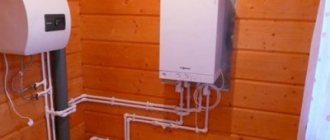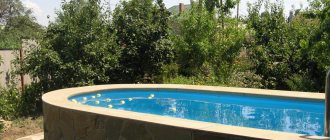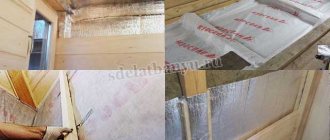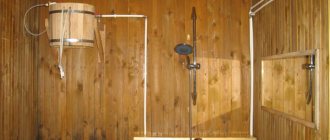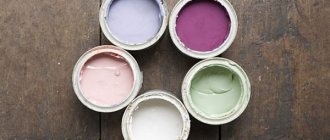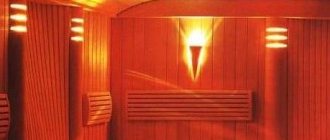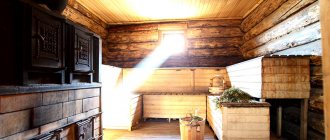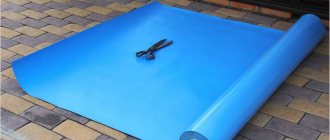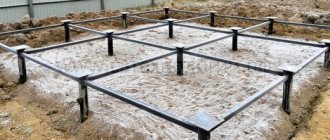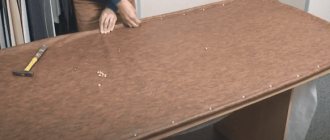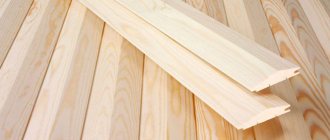Do you need a swimming pool in a bathhouse?
After a hot steam room, you definitely want to quickly and sharply plunge into ice-cold water; without this, the pleasure of the bath will be incomplete. This is a pleasant and effective way of hardening, especially if the procedure is carried out regularly. Besides? In this way, physical and mental fatigue is quickly relieved, the body becomes more stress-resistant and remains young longer. The procedures are recommended for both middle-aged people and children.
Some people are afraid to install a swimming pool at home because of the complexity of its manufacture or the high cost of maintenance. But now there are many options for a hot tub, many of which are inexpensive and can be built quickly.
You should only give up a pool if the bathhouse is very tiny and there is no space for a canopy on the site.
Photo gallery: options for arranging a bathhouse with a swimming pool
Winter forest image creates the illusion of outdoor swimming
Even in a small pool it is worth installing several handrails
Finishing the ends with pebbles is an inexpensive but effective technique
Stones can be used to decorate not only the end of the pool, but also the nearest wall
A mirror wall by the pool will make the room spacious
Rounded edges of the pool - an additional safety measure for families with children
Even in a tiny pool you can relax after a stuffy steam room
Rounding the corners made the pool much more impressive
A grate in the floor around the pool will prevent water from spreading throughout the room
Thanks to the wooden lining of the sides, the plastic pool fits perfectly into the interior of the bathhouse
Plastering walls
As soon as everything is dry, it is necessary to plaster the surface with cement-sand mortar. Its thickness should be 2–3 cm. Since this concerns a pool where water will constantly be present, it is better to use waterproof compounds with latex. Then the plaster will hold strong and for a long time, and thanks to the additives it will be much more elastic and gain better water resistance.
An important step is waterproofing, since we are talking about water. The most economical and fastest option is to use PVC film. It covers the entire surface of the pool bowl. A more expensive and reliable option would be when the inside of the concrete bowl is covered with a special waterproofing material. This could be “Osmosil”, which needs to be applied in two layers to a pre-moistened surface. After which the final layer will be a special adhesive composition, which includes latex. This glue can even hold glass.
Getting ready for construction work
If you prefer a prefabricated or hydromassage pool, you will not have to carry out construction work. You just need to choose a model that is suitable for the price and fits in the allocated room. In the case of a hydromassage font, the selling company often provides installation services and gives a guarantee for the entire system at once.
If you buy a hydromassage pool, entrust the installation to professionals.
But if you like stationary pools, you will have to work hard. In a private bathhouse, we recommend making a skimmer plunge pool, since an overflow plunge pool will take up an unreasonably large amount of space and will require significantly more effort and investment.
Specifying the parameters of the pool
First, let's decide on the depth. If the family has children under adolescence, the pool should not be deeper than 1–1.2 m. A depth of 2 m is needed only for swimming; any adult can plunge headlong into a font measuring 1.5 m. A pool depth of 1.5 m is considered universal. 1.65 m, but if there is a lot of space in the room, you can make a multi-level pool with deep and shallow areas.
Optimally, there should be 2 m2 of pool water per person. If the font is used by a family of four, the best size is 4x2 m.
The length of the pool depends on how it is used. You can just take a dip or splash around with your child in a 2x2 m plunge pool, but for swimming you need at least 5.5 m. In a shallow swimming pool you will also need to install a counterflow system.
The width of the font is determined by the parameters of the zone allocated for it. It is important that the edge of the pool does not come into contact with the walls, so the font should be 0.6–1 m narrower than the distance between the walls, but not less than 1.5 m.
A very impressive pool in the shape of a blot
The shape of the font is limited by the materials used. If you prefer a plastic font, you can choose an option with rounded smooth lines, or a simple round/rectangular bowl. Manufacturers offer a very wide selection of models of different depths, volumes and shapes. Be careful with the dimensions, take into account the required technological gap between the pool and the wall.
The more complex the concrete pool bowl, the higher the risk of cracks
Those who want to cast a concrete bowl can shape the pool as they wish, but the bends and turns should not be too sharp, otherwise the mosaic will have to be trimmed at the cladding stage. Since this is a labor-intensive operation, and the result often does not look aesthetically pleasing, concrete bowls are often made rectangular, sometimes with rounded corners or one of the sides.
With the right skill, blocks can be used to form a very complex pool bowl
Those who build the base of the structure from bricks or blocks have little choice: square, rectangle or trapezoid. Theoretically, it is possible to make a slight bend in such a pool, but this requires great professionalism of the craftsmen. In addition, you will have to apply an uneven layer of plaster, and this is an additional risk of delamination of the structure. Therefore, it is better not to take risks and give preference to simple forms.
Waterproofing
In many ways, the choice of waterproofing type depends on the individual idea of the pool. If tiles are used as a finishing material, then it is advisable to provide liquid waterproofing of the bottom and walls. Only after this can you begin laying tiles on a hydrophobic composition.
It should be remembered that ceramic tiles cannot be used for such a tank, since they have a porous structure: they not only absorb water well, but are also an excellent environment for the formation of fungi and mold. You need to purchase porcelain tiles, which, of course, are more expensive, but more reliable. As an alternative, you can consider glass mosaic tiles.
If PVC film is used for finishing, additional waterproofing is not needed. If desired, you can treat once with a penetrating liquid composition. When choosing such a finishing material, preference should be given to more durable types - at least 3 millimeters thick.
To prevent slipping in the pool, you need to choose a rough film rather than a smooth one. You can choose any colors: plain, with a pattern, the effect of stone chips or mosaics and others.
A capital tank does not have to be a large one; you can also build a small pool in a bathhouse, especially if we are talking about limited free space.
Above ground hot tub with plastic bowl
For such a bowl you don’t even need to rebuild the rim
The easiest way to make a pool is to purchase a plastic bowl and place it at floor level. Then only the supply and discharge pipes will be under the floor, and all other appliances can be placed in the basement. Minimum excavation work, no risk to the foundation, no costs for waterproofing and no complex calculations. From the purchases: the bowl itself, facing panels (you can use the remains of the lining), water pipes made of cross-linked polyethylene or polypropylene, connectors for them, as well as additional devices: pump, filtration system, water heater, skimmer and pressure gauge. You can monitor the quality of water yourself, without automation.
Complex tools are also not needed. A standard gardener's kit will be enough: a jigsaw for trimming the front panels, a mallet for fitting them, the simplest soldering iron for assembling pipes, a sensor, a utility knife and a screwdriver for installing the electrical part of the system.
Those who want to have a built-in automated pool will have to look into excavation robots.
If you are planning to equip your first pool, you will not be able to provide for all the nuances. Therefore, it is best to use ready-made projects, which indicate all the necessary pipes, leads and components. Examples of projects are attached to the article. You can change the parameters of the bowl as you wish. But in no case should you reduce the power of filters or pumps without a reason, otherwise the system will not be able to cope with the load.
Necessary materials
A stationary pool is most often made of concrete. The bottom of the bowl is filled with it, and then the walls are filled with formwork. The most common mortar recipe: cement (1 part), sand (2–3 parts), crushed stone (3–4 parts). To increase water resistance, liquid glass can be added to the solution.
The walls of a surface pool are often made of brick. In this case, it is important to ensure they are waterproof. To do this, apply a primer, waterproofing and cement-sand plaster with additives that increase water resistance.
An important category of materials necessary for arranging a swimming pool is waterproofing. It is applied both on the outside and on the inside of the walls and bottom. External protection should reliably protect against underground and flood waters, and internal waterproofing should prevent water from seeping out of the bowl. There are 2 main types of such materials: coating and roll insulation.
For a sauna pool you can use the following waterproofing materials:
- roofing felt - widely used for waterproofing the bottom from the outside;
- polyethylene film of increased thickness and strength;
- membrane-type films based on PVC, EPDM;
- mastics: Penetron, Calmatron, Xipex mixture and others - belong to the coating category with deep penetration;
- sodium bentonite in the form of mats;
- liquid rubber - with its help a layer of seamless waterproofing is applied;
- impregnating compositions with the ability to polymerize - the most widespread is liquid glass, which can be used as a coating sealant or added to concrete mortar;
- bitumen - has low cost and good waterproofing properties, but has insufficient durability; most often it is used in combination with other elements, for example, roofing felt.
Another group of materials for the pool is necessary for exterior finishing and decorative purposes. Such facing elements stand out in particular.
- Ceramic tiles (tiles). In pool conditions, it does not have much durability, but despite this, it remains one of the most popular materials, because it provides a pleasant appearance and is easy to install with your own hands. It also attracts the possibility of simple repair of damaged elements.
- Porcelain and glass mosaic. It is recognized as the best material for lining pools. It has high water resistance, wear resistance, strength, and a wide range of colors.
- Polymer boards and films. PVC with a thickness of at least 3 mm is most often used.
- Ready-made plaster mixture with an additive in the form of ceresite emulsion.
When making portable structures with your own hands, sheet plastic, metal, and rubber are used. A sufficiently spacious font can be built from ready-made containers - these are pallets, plastic and metal tanks.
